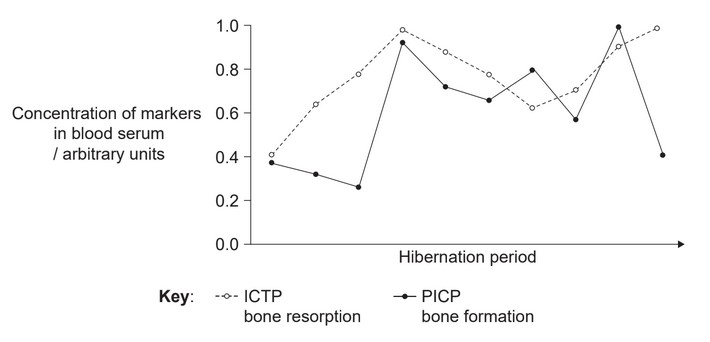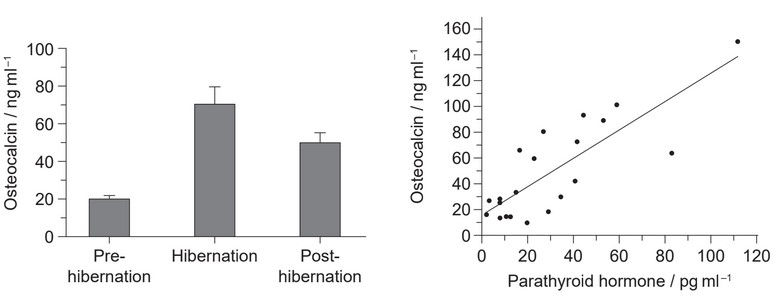Question
In winter when temperatures drop, brown bears (Ursus arctos) enter a cave and hibernate. The graph shows the mean values for the body temperature, heart rate and activity of 14 brown bears throughout the year. The grey shaded areas indicate the periods when the bears are in transition between hibernation and normal activity.
(a) Estimate the difference between the highest and lowest mean body temperatures.
(b) Compare and contrast the changes in mean ambient and body temperatures during 2012.
(c) Explain the change in heart rate during the period of hibernation.
It was observed that during hibernation bears are not susceptible to osteoporosis, a condition characterized by a decrease in the density of bone, resulting in porous and fragile bones. This condition may develop in humans during long periods of inactivity and with increasing age. The graph shows the porosity of the tibia bones of black bears (Ursus americanus) and humans at different ages. Age is expressed as the proportion of normal life span.
(d) Distinguish between the changes in porosity of the bones in humans and bears as age increases.
(e) The life expectancy of a human at the time of the study was 80 years. Estimate the porosity of the bones of the individual who was approximately 32 years old.
(f) The researchers assessed age as a proportion of normal life span, rather than in years.
Suggest one reason for this.
Healthy bone is constantly being broken down (bone resorption) and at the same time being rebuilt (bone formation). Bone mass should therefore not normally change, nor
bone diseases occur. To test whether these processes occurred during hibernation in black bears, blood serum was tested for the markers ICTP (indicating bone resorption) and PICP (indicating bone formation).
(g) Describe what is happening to the bone during hibernation.
(h) Suggest how the graph would differ for a human during a long period of inactivity.
Osteocalcin is a peptide hormone that causes calcium to bind in the bones, so is involved in bone formation and regeneration. Research shows that changes in the mean concentration of osteocalcin in blood serum occur before and after hibernation in bears. In this research, concentration of both osteocalcin and parathyroid hormone were measured in the blood serum of bears. Results are shown in the bar chart and graph.
(i) Calculate the percentage increase in the mean concentration of osteocalcin from pre-hibernation to hibernation.
(j) A hypothesis has been proposed that an increase in parathyroid hormone concentration causes an increase in osteocalcin in bears. Evaluate the evidence for this hypothesis provided by the data.
(k) Discuss how helpful these studies of bears can be in developing an understanding of osteoporosis in humans.
Answer/Explanation
Ans:
(a). 50 C;
(b). Accept one similarity:
a. both rise and then fall / both fall with hibernation and rise with activity
b. both reach minimum during hibernation and maximum during activity;
c. both lowest in January/February / both rise from January/February;
Accept one difference:
d. one peak of ambient temp but body temp has two peaks / OWTTE;
e. body temp remains maximal for longer/plateaus whereas ambient peaks;
f. body temperature is always higher than ambient temperature;
g. ambient range is greater than body temperature range / OWTTE;
(c).
a. decreased/slower heart rate because bears less active/use less energy;
b. less (cell) respiration / lower (rate of) metabolism;
c. less oxygen/glucose required / less CO2 produced/needing to be removed;
d. less muscle contraction/muscles require less blood;
a. e. conserves energy;
(d). porosity increased in humans and decreased in bears;
(e). 6 %;
(f).
a. to allow comparison of bears and humans;
b. bears have a different life span to humans / bears do not live to 80 years;
c. because they age at different rates;
(g).
a. resorption/breaking down occurs and formation/rebuilding occurs;
b. at similar rates / more resorption at most times;
c. no/little (overall) change (in bone mass);
d. lag between bone resorption rising and formation rising / OWTTE;
e. bone resorption rising towards end as formation dropping / OWTTE;
(h).
a. more resorption than formation;
b. PICP/bone formation (always) lower (than in bears);
c. ICTP/bone resorption (always) higher (than in bears);
d. ICTP above PICP by a greater amount in humans (than in bears);
(i). 250 % (Allow 240 to 260%)
(j).
a. (hypothesis supported by)
positive/direct correlation/direct relationship (between parathyroid hormone and osteocalcin)
OR
osteocalcin rises as parathyroid hormone rises/vice versa;
b. no evidence for causal link / causal link cannot be assumed / correlation does not prove
causation;
OR
no evidence that parathyroid hormone causes change in osteocalcin;
OR
other factors may cause change in osteocalcin;
(k). Accept one reason for the studies being helpful:
a. (helps us understand how)) bears avoid osteoporosis;
b. bone structure of bears and humans is similar / both are mammals;
c. suggests that hormones/osteocalcin/parathyroid hormone might be a (preventative)
treatment;
Accept one reason for the studies not being helpful:
d. humans do not hibernate / are not inactive for long periods;
Question
The graph shows the mean annual changes in global temperatures between 1880 and 2014.
The mean temperature from 1951 to 1980 was used as the value of zero change in temperature.
(a) Calculate the increase in mean global temperature between 1880 and 2010.
(b) Outline how changes in temperature over short time periods could give a misleading impression of changes to the Earth’s climate.
(c) Explain how increased carbon dioxide in the air leads to the greenhouse effect.
Answer/Explanation
Ans:
(a) 0.87
(b)
a. short-term reading could show global temperatures falling while the trend is rising;
b. fluctuations from year to year may not show long-term trend;
(c) a. short wave radiation from sun passes through atmosphere/is not absorbed by CO2;
b. infrared/long wave (radiation)/heat emitted from/released from (surface of) Earth;
c. CO2 in the atmosphere absorbs infrared/long wave (radiation) / heat cannot pass through
the greenhouse gases;
